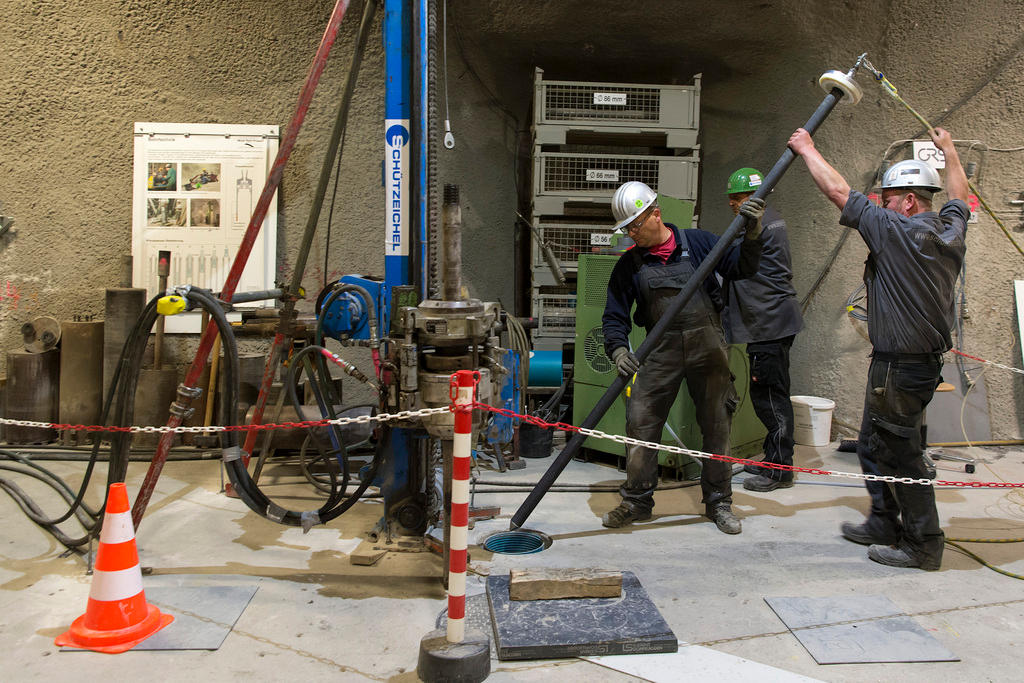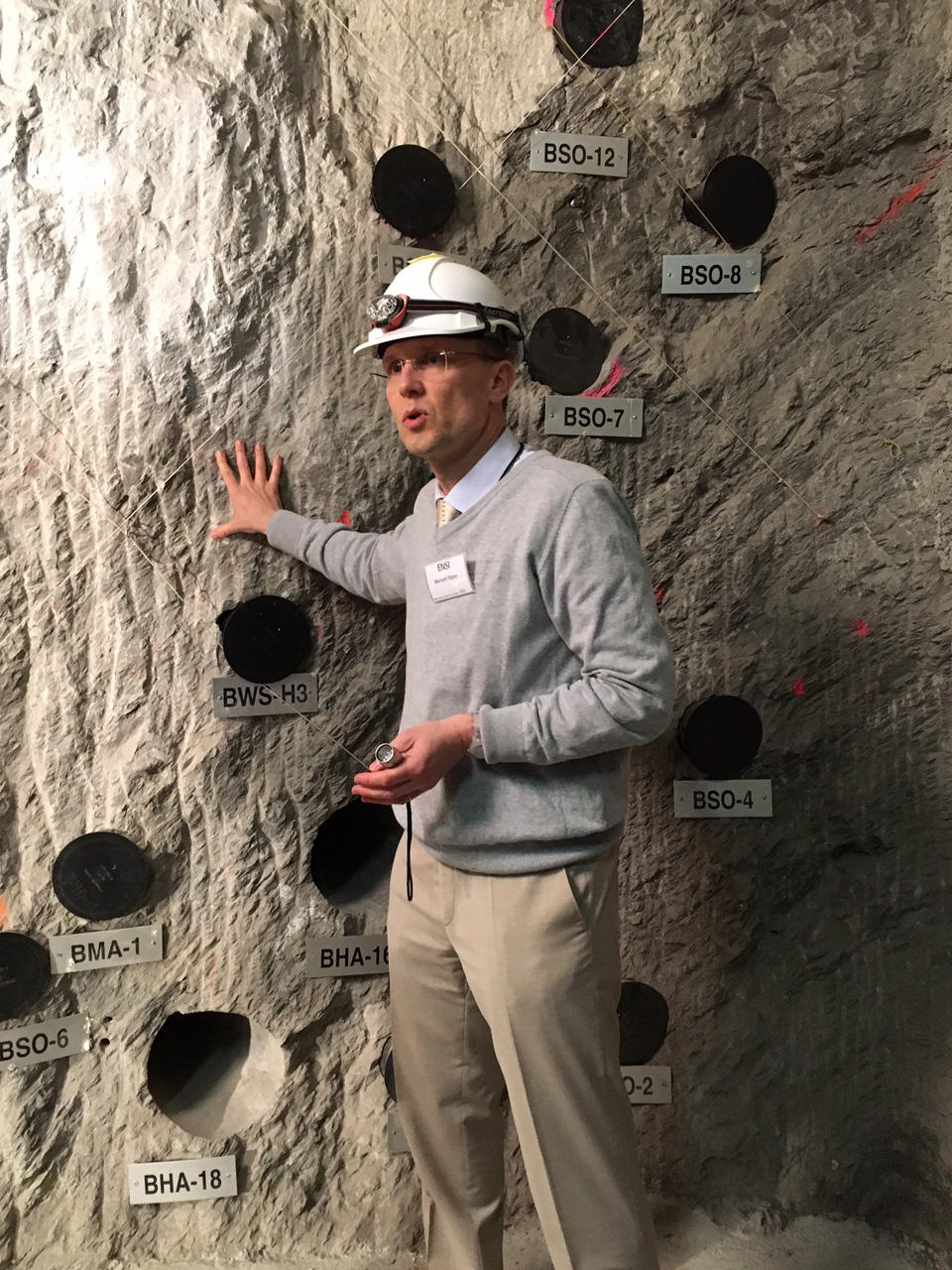
Nuclear waste is no match for ancient rock

A special type of clay found beneath Swiss soil could solve the dilemma of what to do with the thousands of cubic metres of waste that will remain after Switzerland’s five nuclear power plants shut down.
If you join one of the subterranean tours at the Mont Terri Rock Laboratory in St Ursanne, canton Jura, the first thing you will see as you make the 300-metre descent is a dark tunnel lined with seeping, moist rock.
Go on a bit further, and suddenly the walls of the tunnel become bone dry. This marks the geological transition between limestone and Opalinus Clay – and for the Mont Terri Project (MTP) scientists, it’s as good as striking gold.
Despite being hard to the touch, the dark grey material is classified as a clay mineral due to its geological composition, making it distinct from the soft, mouldable material we usually think of when we think of clay. It was formed in Switzerland 175 million years ago during the Jurassic period, when the land was covered by a shallow sea. Opalinus Clay gets its name from a species of ammoniteExternal link called Leioceras opalinum, which has a pearly, opalescent sheen to its shell, and was found fossilised within the rock.

More
Nuclear underground
Incredibly, small amounts of seawater still remain trapped in the clay’s minute pores – living proof of its ability to prevent liquid from moving through it. And this is exactly why Opalinus Clay is so interesting to researchers: it has such a low degree of permeability that it is practically watertight, and can even seal itself back up again after it has been fractured.
That means that nuclear waste surrounded by Opalinus Clay could be effectively sealed off, keeping the rest of the world safe from harmful radioactive particles.
An international consortium
The Mont Terri Project, launched in 1996, is a collaboration between 16 partners from eight countries. The laboratory in St Ursanne provides some 700 metres worth of research galleries, each dedicated to projects relating to radioactive waste disposal and carbon sequestration. The project has run 130 experiments over the last two decades, 45 of which are still in operation, and employs some 1,000 scientists, engineers and technicians.
About CHF75 million ($75.6 million) has been invested in the laboratory, and most of the funding comes from the project partners themselves. As of 2005, the operation and safety of the rock laboratory has been the responsibility of swisstopoExternal link, the Swiss Federal Office of Topography – a division of the Swiss defence ministry.
“If it works here, it works elsewhere”
The Mont Terri Rock Laboratory is not itself a potential nuclear waste storage site. Instead, the facility is dedicated to 1:1 scale experiments designed to address all possible safety and feasibility issues related to using Opalinus Clay for the long-term geological storage of radioactive waste.

The knowledge gained from the project will be used to help Switzerland, as well as the MTP’s international partners, select appropriate nuclear waste storage sites in the future.
“Whether or not to build a repository for radioactive waste is a political question. But on the location of such a repository, it is science that must have the decisive say,” said Markus Kägi, Chairman of the Committee of the Cantons in the Swiss Sectoral Plan for Deep Geological Repositories, in a statement at the MTP’s 20th anniversary event in May.
“Experiments need room even for what may be a failure at the first attempt. At Mont Terri we can afford failures. At the location of the actual repository, though, there will be no room for slip-ups”.
Experiments in the galleries of Mont Terri’s cavernous laboratory focus on characterising the Opalinus Clay itself, and on devising safe containers and barriers for waste materials. For example, to determine how well the rock contains radioactive particles, scientist inject controlled amounts of radioactive tracer into it, and then test it after one year to see how far the tracer particles have moved.
Researchers also monitor the area for earthquakes and study the effect of seismicity on the clay, since storing hazardous materials underground means that movements of the earth’s tectonic plates can pose a real stability risk to future repositories.
In fact, MTP Director Paul Bossart notes that the rock laboratory is actually situated in a region that is especially active, seismically speaking – and that this is a good thing, because: “if it works here, it works elsewhere”.
Digging deeper
Bossart told swissinfo.ch that although Opalinus Clay is widespread in Switzerland and other parts of Europe, strict criteria must be satisfied before a site can be considered for a potential nuclear waste repository.
“From Geneva to St Gallen, when you make a borehole in the ground, you will find Opalinus Clay. It is also found in southern Germany – the whole area it covers is about 100,000 square kilometres, or twice the area of Switzerland,” Bossart says. “But at a depth of three kilometres you cannot construct a [nuclear waste] repository – a good depth is between 400-900 metres. And there are also [areas that glaciers may cover] in the future, and you must avoid these, because there is a risk the glacier could disrupt the waste.”
Thanks to work being done at the Mont Terri Rock Laboratory, as well as at partner institutions – including three other clay rock laboratories and NagraExternal link, the Swiss technical competence centre for deep geological disposal of radioactive waste – the MTP has concluded that Opalinus Clay is a “robust” material for containing highly radioactive material over very long time periods.
But much more remains to be known about this unique rock and its properties.
For one thing, despite its advantages as a natural barrier, Opalinus Clay does not conduct heat well; unless it is spread out over large areas, nuclear waste could cause the clay to become overheated. Opalinus Clay is also not very structurally strong, so it’s an engineering challenge to create stable constructions to house the waste.
Researchers are also very interested in using Opalinus Clay as a place to sequester excess carbon dioxide – one of the leading greenhouse gases. But more tests must be done to determine whether injecting CO2 into the rock could have adverse effects, such as earthquakes or groundwater contamination.
To delve deeper into these questions and challenges, the MTP has plans for a CHF5 million extension of the rock laboratory beginning in 2018, and ten project proposals are currently being considered for a new research programme beginning in 2020.
“I think when you really want to construct a repository, you need to have a safety case taking into account all the arguments – research, in-situ testing and natural analogues,” says Bossart.
“In natural analogue studies, we can study what happened in the past to make our conclusions for the future…at Mont Terri for example, we can look into the past about six million years by studying the pore water.”
Radioactivity basics
Radiation is a form of energy, and one that most of us are exposed to at low levels every day. Naturally radioactive materials, such as uranium, thorium, radon, and some forms of potassium and carbon, spontaneously emit radiation when the nucleus of an unstable atom falls to a lower energy state. This is known as radioactive decay. Human tissues can become damaged at very high levels of radiation exposure, which is often measured in millisieverts (mSv). Cancer risk is raised at levels of 200-1,000 mSv, while death occurs in about 50% of people exposed to levels of 8,000 mSv and above. For comparison, a round-trip intercontinental flight results in about 0.03-0.06 mSv of radiation, while the legal limit for radiation exposure in a professional setting in Switzerland is 20 mSv.
Nuclear waste in Switzerland
Most of Switzerland’s radioactive waste comes from its five nuclear power plants, although some also comes from research, the healthcare sector, and industry. Switzerland has decided not to create any new nuclear plants, and so the five existing ones will be shut down at the end of their lifetimes. The Swiss Federal Office of Energy estimates that by this time, some 100,000 cubic metres of radioactive material will need to be disposed of safely. The Swiss Federal Nuclear Energy ActExternal link therefore specifies that a deep storage geological repository must be found. Until such a long-term solution is decided upon, Switzerland’s nuclear waste resides above ground in special storage facilities in canton Aargau.
Looking to the future
The intergovernmental Organisation for Economic Co-operation and Development (OECD) Nuclear Energy Agency (NEA) released a report in May entitled, “Radioactive Waste Management and Constructing Memory for Future GenerationsExternal link” (PDF).
The report summarises the proceedings of a 2014 conference of the NEA’s Radioactive Waste Management Committee (RWMC), which Swiss delegates attended, on the preservation of records, knowledge and memory (RK&M) across generations on matters of nuclear waste management – including deep geological repositories.
The goal of the conference was to develop strategies to help future generations consider and make informed choices about nuclear waste, many years and even centuries after the people and organisations who have established current management practices are gone.
How is nuclear waste disposed of in your country? How would you feel about an underground nuclear waste repository in your area?

In compliance with the JTI standards
More: SWI swissinfo.ch certified by the Journalism Trust Initiative
































You can find an overview of ongoing debates with our journalists here . Please join us!
If you want to start a conversation about a topic raised in this article or want to report factual errors, email us at english@swissinfo.ch.